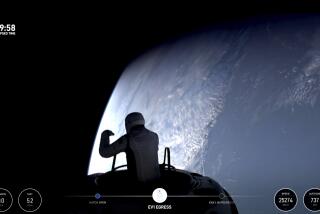Salvaged rocket came from Apollo 11: Remembering the moonwalk
- Share via
One day short of the 44th anniversary of Apollo 11’s lunar landing, Amazon.com founder Jeff Bezos announced that a rocket engine fished out of the Atlantic Ocean by an expedition he was leading had been part of the historic mission.
NASA and Bezos confirmed Friday that debris recovered in March was one of the F-1 engines from the Saturn V rocket that had propelled Apollo 11 toward the moon.
“Forty-four years ago tomorrow Neil Armstrong stepped onto the moon, and now we have recovered a critical technological marvel that made it all possible,” Bezos wrote on his blog.
It was a fitting time to make the announcement, as people around the world commemorate the first moonwalk.
On July 20, 1969, Armstrong and Buzz Aldrin climbed out of their spacecraft and spent nearly three hours on the lunar surface -- walking about, collecting samples and taking pictures. (Command module pilot Michael Collins remained in lunar orbit.) Armstrong famously uttered that it was “one small step for man, one giant leap for mankind” -- though Armstrong would later say that what he really said was that it was “one small step for a man.”
OBITUARY: Neil Armstrong, 1930-2012
The day after the Apollo landing, Los Angeles Times reporters Marvin Miles and Rudy Abramson described the landing to rapt readers back in California.
“U.S. astronauts stepped onto the surface of the moon Sunday and explored its bleak, forbidding crust in man’s first visit to another celestial body,” they wrote. About seven hours prior, they reported, Armstrong had to take manual control of the lunar lander vehicle to assure a safe landing.
They described how Aldrin jumped on the lunar surface in front of television cameras, to “determine the effect of the moon’s weight gravity on his balance and coordination.” They recounted Armstrong’s descriptions of what he saw -- a surface that “appears fine-grained, almost like a powder,” a place that was “different, but beautiful” -- and threw in a summary of their own about the images from Aldrin’s camera: “The scenes showed clearly the utter desolation of the moon -- the rough, scarred terrain, in what appeared to be scores of small craters. The pictures showed a couple of elongated craters, and in the distance small rocks.”
MOON HISTORY: JFK’s 1962 speech, 50 years later
The men planted an American flag in the lunar soil, Miles and Abramson reported, and then took a call from President Nixon, who told them, “Because of what you’ve done, the heavens have become a part of man’s world.” Throughout the mission, The Times added, the astronauts’ heart rates ranged between 90 and 100 beats per minute.
Today, space exploration fans can view restored, high-definition footage of the historic spacewalk on NASA’s website.







